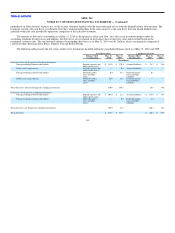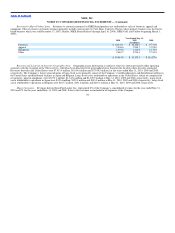Nike 2010 Annual Report Download - page 90
Download and view the complete annual report
Please find page 90 of the 2010 Nike annual report below. You can navigate through the pages in the report by either clicking on the pages listed below, or by using the keyword search tool below to find specific information within the annual report.
Table of Contents NIKE, INC.
NOTES TO CONSOLIDATED FINANCIAL STATEMENTS — (Continued)
When the Company discontinues hedge accounting because it is no longer probable that the forecasted transaction will occur in the originally
expected period, or within an additional two−month period of time thereafter, the gain or loss on the derivative remains in accumulated other comprehensive
income and is reclassified to net income when the forecasted transaction affects net income. However, if it is probable that a forecasted transaction will not
occur by the end of the originally specified time period or within an additional two−month period of time thereafter, the gains and losses that were
accumulated in other comprehensive income will be recognized immediately in net income. In all situations in which hedge accounting is discontinued and
the derivative remains outstanding, the Company will carry the derivative at its fair value on the balance sheet, recognizing future changes in the fair value
in other (income) expense, net. For the year ended May 31, 2010, $5.2 million of income was recorded to other (income) expense, net as a result of cash
flow hedge ineffectiveness. For the years ended 2009 and 2008, the Company recorded in other (income) expense an immaterial amount of ineffectiveness
from cash flow hedges.
Fair Value Hedges
The Company is also exposed to the risk of changes in the fair value of certain fixed−rate debt attributable to changes in interest rates. Derivatives
currently used by the Company to hedge this risk are receive−fixed, pay−variable interest rate swaps. As of May 31, 2010, all interest rate swap agreements
are designated as fair value hedges of the related long−term debt and meet the shortcut method requirements under the accounting standards for derivatives
and hedging. Accordingly, changes in the fair values of the interest rate swap agreements are exactly offset by changes in the fair value of the underlying
long−term debt. The cash flows associated with the Company’s fair value hedges are periodic interest payments while the swaps are outstanding, which are
reflected in net income within the cash provided by operations component of the cash flow statement. No ineffectiveness has been recorded to net income
related to interest rate swaps designated as fair value hedges for the years ended May 31, 2010, 2009 and 2008.
In fiscal 2003, the Company entered into a receive−floating, pay−fixed interest rate swap agreement related to a Japanese Yen denominated
intercompany loan with one of the Company’s Japanese subsidiaries. This interest rate swap was not designated as a hedge under the accounting standards
for derivatives and hedging. Accordingly, changes in the fair value of the swap were recorded to net income each period through maturity as a component of
interest expense (income), net. Both the intercompany loan and the related interest rate swap matured during the year ended May 31, 2009.
Net Investment Hedges
The Company also hedges the risk of variability in foreign−currency−denominated net investments in wholly−owned international operations. All
changes in fair value of the derivatives designated as net investment hedges, except ineffective portions, are reported in the cumulative translation
adjustment component of other comprehensive income along with the foreign currency translation adjustments on those investments. The Company
classifies the cash flows at settlement of its net investment hedges within the cash used by investing component of the cash flow statement. The Company
assesses hedge effectiveness based on changes in forward rates. The Company recorded no ineffectiveness from its net investment hedges for the years
ended May 31, 2010, 2009, and 2008.
Credit Risk
The Company is exposed to credit−related losses in the event of non−performance by counterparties to hedging instruments. The counterparties to all
derivative transactions are major financial institutions with investment grade credit ratings. However, this does not eliminate the Company’s exposure to
credit risk with
87
























